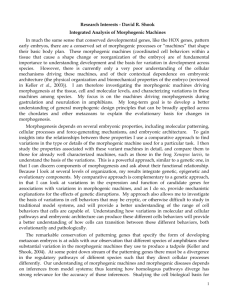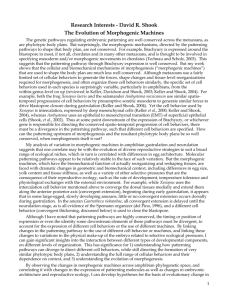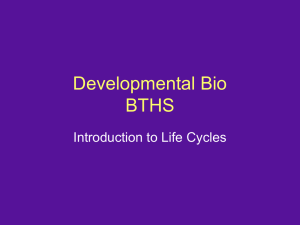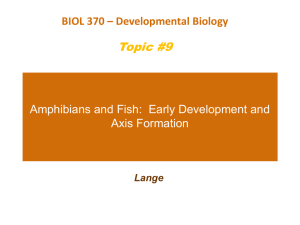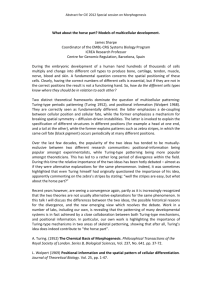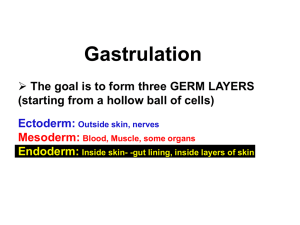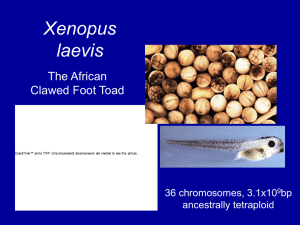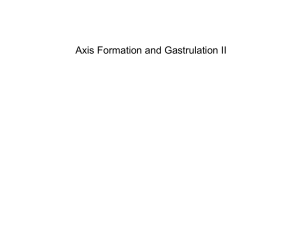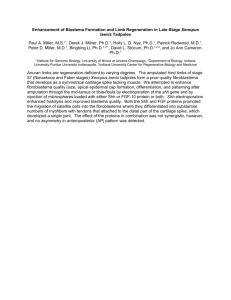Where do referees go
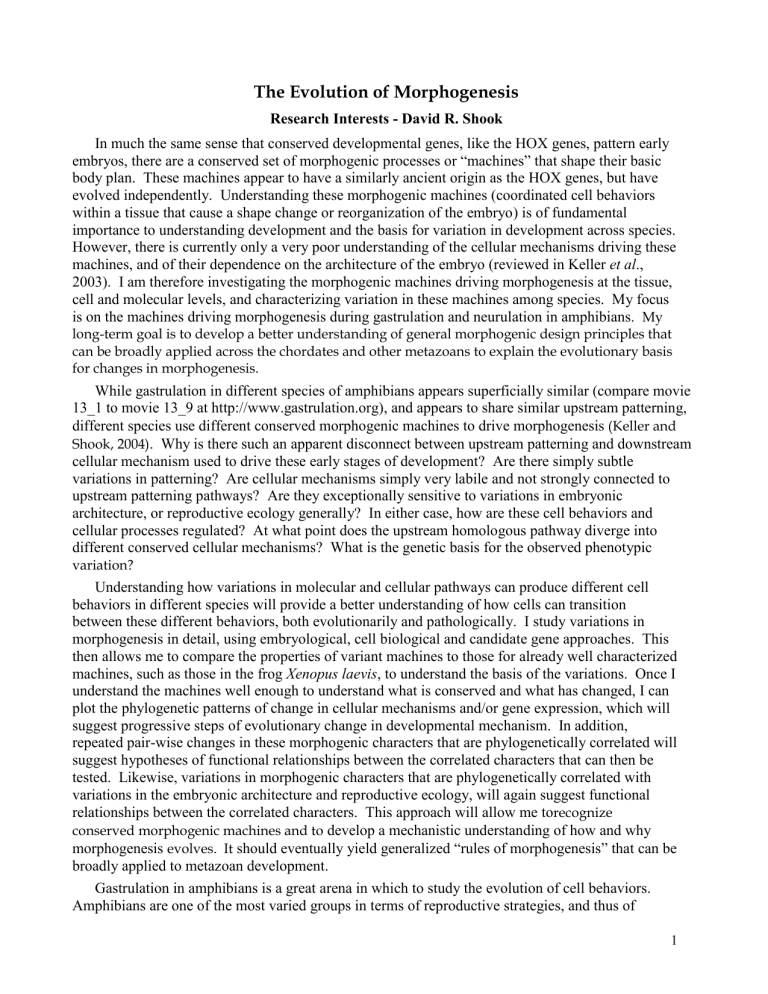
The Evolution of Morphogenesis
Research Interests - David R. Shook
In much the same sense that conserved developmental genes, like the HOX genes, pattern early embryos, there are a conserved set of morphogenic processes or “machines” that shape their basic body plan. These machines appear to have a similarly ancient origin as the HOX genes, but have evolved independently. Understanding these morphogenic machines (coordinated cell behaviors within a tissue that cause a shape change or reorganization of the embryo) is of fundamental importance to understanding development and the basis for variation in development across species.
However, there is currently only a very poor understanding of the cellular mechanisms driving these machines, and of their dependence on the architecture of the embryo (reviewed in Keller et al .,
2003). I am therefore investigating the morphogenic machines driving morphogenesis at the tissue, cell and molecular levels, and characterizing variation in these machines among species. My focus is on the machines driving morphogenesis during gastrulation and neurulation in amphibians. My long-term goal is to develop a better understanding of general morphogenic design principles that can be broadly applied across the chordates and other metazoans to explain the evolutionary basis for changes in morphogenesis.
While gastrulation in different species of amphibians appears superficially similar (compare movie
13_1 to movie 13_9 at http://www.gastrulation.org), and appears to share similar upstream patterning, different species use different conserved morphogenic machines to drive morphogenesis (Keller and
Shook, 2004) . Why is there such an apparent disconnect between upstream patterning and downstream cellular mechanism used to drive these early stages of development? Are there simply subtle variations in patterning? Are cellular mechanisms simply very labile and not strongly connected to upstream patterning pathways? Are they exceptionally sensitive to variations in embryonic architecture, or reproductive ecology generally? In either case, how are these cell behaviors and cellular processes regulated? At what point does the upstream homologous pathway diverge into different conserved cellular mechanisms? What is the genetic basis for the observed phenotypic variation?
Understanding how variations in molecular and cellular pathways can produce different cell behaviors in different species will provide a better understanding of how cells can transition between these different behaviors, both evolutionarily and pathologically. I study variations in morphogenesis in detail, using embryological, cell biological and candidate gene approaches. This then allows me to compare the properties of variant machines to those for already well characterized machines, such as those in the frog Xenopus laevis , to understand the basis of the variations. Once I understand the machines well enough to understand what is conserved and what has changed, I can plot the phylogenetic patterns of change in cellular mechanisms and/or gene expression, which will suggest progressive steps of evolutionary change in developmental mechanism. In addition, repeated pair-wise changes in these morphogenic characters that are phylogenetically correlated will suggest hypotheses of functional relationships between the correlated characters that can then be tested. Likewise, variations in morphogenic characters that are phylogenetically correlated with variations in the embryonic architecture and reproductive ecology, will again suggest functional relationships between the correlated characters. This approach will allow me to recognize conserved morphogenic machines and to develop a mechanistic understanding of how and why morphogenesis evolves. It should eventually yield generalized “rules of morphogenesis” that can be broadly applied to metazoan development.
Gastrulation in amphibians is a great arena in which to study the evolution of cell behaviors.
Amphibians are one of the most varied groups in terms of reproductive strategies, and thus of
1
embryonic architecture. This in turn is strongly correlated with variations in gastrulation mechanisms. My research focuses on variations in force producing mechanisms driving gastrulation. The large size of amphibian cells allows me to easily visualize both the localization of components within cells, as well as the behaviors and movements of the cells themselves.
Visualization of cell movements and morphogenic machines is further facilitated because amphibian embryos are uniquely amenable to microsurgery and explants survive well in culture, making it easy for me to image otherwise hidden regions of the embryo (see movies 13_1 to 13_14 at http://www.gastrulation.org). I can also compare the operation of these machines in isolation by explanting tissues, or in novel contexts, by transplanting them. I can compare machines in the context of different embryonic architectures or different complements of other machines by looking at similar machines operating in different species. Looking at a morphogenic movement in different contexts allows me to discern individual machines and understand their dependence on context, to understand which machines actually produce specific morphogenic movements. The system I have developed to look at cell behaviors and force production by subduction allows me to take advantage of all these features.
Current Work : Different amphibians use different morphogenic machines to drive germ layer reorganization (e.g. Gastrulation). In order to understand the evolutionary basis for this divergence, we need to understand how these machines function, and how they are regulated in diverse species.
I am currently investigating the cellular mechanism, biomechanics and patterning of a force producing morphogenic machine, “subduction”, that drives gastrulation in the salamander
Ambystoma mexicanum . Subduction involves apical constriction, ingression and epithelial to mesenchymal transition (EMT) just inside the blastopore, adjacent to the vegetal endoderm (Shook et al ., 2002). Subduction resembles primitive streak ingression in amniotes (Shook and Keller,
2003) and is very different from the mediolateral cell intercalation behavior (MIB) used by the frog,
Xenopus laevis (Keller et al ., 2000). In collaboration with Lance Davidson, I have developed a force measuring assay and have shown that subduction is a force producing machine. I have also shown that it is dependent on a myosin II based contraction mechanism, probably in the apical cortex of apically constricting cells, and that actin is preferentially localized to the apical cortex of cells entering the region where subduction behaviors begin. In collaboration with Bill Bement, I am using a probe for activated RhoA to visualize the activation pattern of the force producing mechanism in live explants undergoing subduction.
Subduction occurs in the same spatial and temporal progression during gastrulation as MIB in
Xenopus , to produce similar biomechanical forces to achieve the same morphogenic end, namely involution and blastopore closure. This suggests that I have an example of a homologous upstream patterning pathway, which somehow diverges to produce different cell behaviors. To understand both the initial patterning and the divergence of the downstream regulatory pathway, I am investigating the specification of superficial presumptive mesodermal cells to learn how and when they are directed to ingress and undergo EMT. Whereas Ambystoma ingresses most of its large field of superficial presumptive mesoderm during gastrulation, X. laevis ingresses its few superficial presumptive mesodermal cells during neurulation (Shook et al ., 2004). This delay suggests a change in the timing of mesodermal specification and differentiation, e.g. to ingress and go through
EMT in these cells. To determine which genes direct these behaviors, I am testing candidates likely to be involved, based on work in Xenopus and other systems. Differences in expression of candidate genes that are correlated with the timing of ingression in the two species will suggest involvement in its regulation, which can be tested using antimorphic genetic reagents (e.g. dominant negative constructs and antisense technologies).
2
Comparing the morphogenic machines that close the blastopore in different species has brought to light a previously poorly understood morphogenic machine and provided a robust model system in which to study it. X. laevis is thought to use a robust anisotropic (dorsally focused) axial convergence and extension machine to close its blastopore during gastrulation, but the use of dorsally focused convergence and extension is delayed until after gastrulation in the marsupial frog,
Gastrotheca riobambae (del Pino, 1996), and is used only weakly during gastrulation in other anurans, such as the dart frog Epipedobates tricolor and the direct developing frog
Eleutherodactylus coqui (Shook & Elinson, unpublished results). E. tricolor , E.
coqui and G. riobambae instead use a robust “isotropic convergence” machine that converges equally around the blastopore, leading to isotropic blastopore closure without substantial axial extension (Shook, unpublished results), a behavior that is only cryptically expressed in X. laevis gastrulae (Keller and
Danilchik, 1988). Isotropic convergence may be an ancestral mechanism for amphibians, and perhaps chordates generally. I am therefore collaborating with Dr. Eugenia del Pino to continue characterizing morphogenesis in G. riobambae and E. tricolor , and with Dr. Rick Elinson in E.
coqui , to develop a model system to study the cell behavioral basis of the isotropic convergence machine, and with Dr. Chris Lowe to look at isotropic convergence in hemichordate gastrulation. I will also look more closely at X. laevis to understand how it works there.
Planned Research : I will continue the work begun in the Keller lab, and expand to other morphogenic machines and amphibian species as the size of my lab expands. My specific aims reflect the three aspects of my work: determining the cellular mechanisms underlying the cell behaviors driving morphogenic machines and the biomechanical effects they produce; understanding the specification and patterning of cell behaviors; exploration of further phylogenetic variations in the morphogenic machines used to drive morphogenic movements; and mapping variations in morphogenic characters onto amphibian phylogeny to map evolutionary changes in development.
Specific Aims:
1) In order to gain a detailed understanding of morphogenic mechanisms, such that I can ask meaningful questions about their evolutionary divergence, I will determine the cellular basis of superficial presumptive mesoderm EMT and of the associated force producing behavior, using subduction in Ambystoma mexicanum as a model system. I will: A) test the role of likely candidate molecules (e.g. apical junctional components, actin, myosin, Rho GTPases) in cell behaviors and force production, using specific pharmacological and antimorphic genetic inhibitors; B) characterize the dynamic localization of these molecules. I will also investigate the specification and patterning of the superficial cells of the marginal zone in X. laevis and A. mexicanum to understand: A) how superficial presumptive mesoderm is specified differently than the adjacent superficial endoderm; B) how superficial mesoderm is specified to ingress and undergo EMT, and to do so at the right time and place. I will characterize the expression of candidate molecules suspected of being involved in specifying any aspect of superficial mesoderm differentiation, and will test the role of those expressed in the right time and place with antimorphic genetic techniques.
2) In order to broaden the range of known morphogenic machines, and to identify conserved morphogenic machines, I will continue to compare species with diverse gastrulation movements, initially using embryological approaches. By comparing the effects of machines in different contexts, or species that use different sets of machines at a specific stage, I can determine the biomechanical forces and resulting morphogenic distortions produced by each machine. A valuable by-product of this comparative approach is the discovery of species with especially
3
robust versions of a particular machine, species that can be used as model systems for the detailed study of the cell biology and patterning controlling that machine, as above.
3) In order to develop an understanding of a set of general “rules of morphogenesis” and the evolution of morphogenesis, I will gather data on morphogenic characters, including variations in morphogenic machines, their constituent cell and molecular biology components, and corresponding embryonic architectures and reproductive ecologies for as broad a phylogenetic distribution of amphibians as is practical. The distribution of these characters will then be tested for correlations, to determine whether specific changes occur together reproducibly in different lineages, suggesting potential causal relationships.
Funding : I have recently submitted my initial RO1 NIH grant application (10/1/04). The grant is focused on the cell biological and patterning aspects of my work (Specific Aim 1). The ACS may also be interested in funding my work on ingression and EMT. Once I have secured NIH funding, I will acquire NSF funding for my more explicitly comparative evolutionary research (Specific Aims
2 and 3).
My first attempt at grant writing, for postdoctoral funding (NRSA) for my work on superficial presumptive mesoderm, was funded by the NIH with a high score. I have been successful in convincing review panels that my approach, described above, has relevance from the biomedical and human health perspective. The importance of my work with Dr. del Pino was recognized by the editors of Development, who awarded me a travelling fellowship to set up my initial collaboration with her in Ecuador. I have participated in writing several RO1s in the Keller lab, all of which have been funded. I am confident that I will be able to obtain further funding for my unique, innovative and highly integrated line of research, addressing as it does fundamental questions about the mechanisms and evolution of morphogenesis, including questions of basic biomedical interest, such the mechanisms of cell motility, ingression and EMT.
References del Pino, E. M. (1996). The expression of brachyury (T) during gastrulation in the marsupial frog
Gastrotheca riobambae . Developmental Biology 177, 64-72.
Essex, L. J., Mayor, R., and Sargent, M. G. (1993). Expression of Xenopus snail in mesoderm and prospective neural fold ectoderm. Developmental Dynamics 198, 108-22.
Keller, R., and Danilchik, M. (1988). Regional expression, pattern and timing of convergence and extension during gastrulation of Xenopus laevis. Development 103, 193-209.
Keller, R., Davidson, L., Edlund, A., Elul, T., Ezin, M., Shook, D., and Skoglund, P. (2000).
Mechanisms of convergence and extension by cell intercalation. Philosophical Transactions of the Royal Society of London Series B: Biological Sciences 355, 897-922.
Keller, R., Davidson, L. A., and Shook, D. R. (2003). How we are shaped: The biomechanics of gastrulation. Differentiation 71, 171–205.
Keller, R., and Shook, D. (2004). Gastrulation in Amphibians. In “Gastrulation: From Cells to
Embryo” (C. D. Stern, Ed.). Cold Spring Harbor Laboratory Press, Cold Spring Harbor, NY.
Shook, D., and Keller, R. (2003). Mechanisms, mechanics and function of epithelial-mesenchymal transitions in early development. Mechanisms of Development 120, 1351-1383.
Shook, D. R., Majer, C., and Keller, R. (2002). Urodeles remove mesoderm from the superficial layer by subduction through a bilateral primitive streak. Developmental Biology 248, 220-239.
Shook, D. R., Majer, C., and Keller, R. (2004). Pattern and morphogenesis of presumptive superficial mesoderm in two closely related species, Xenopus laevis and Xenopus tropicalis .
Developmental Biology 270, 163-185.
4
